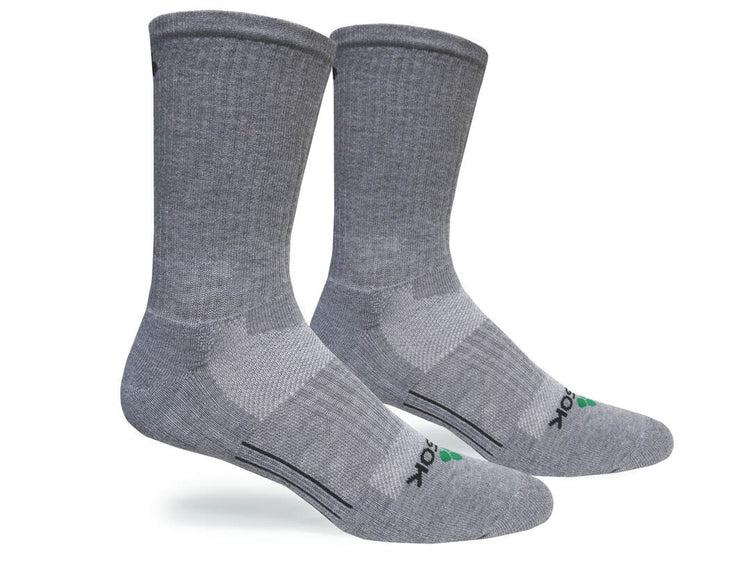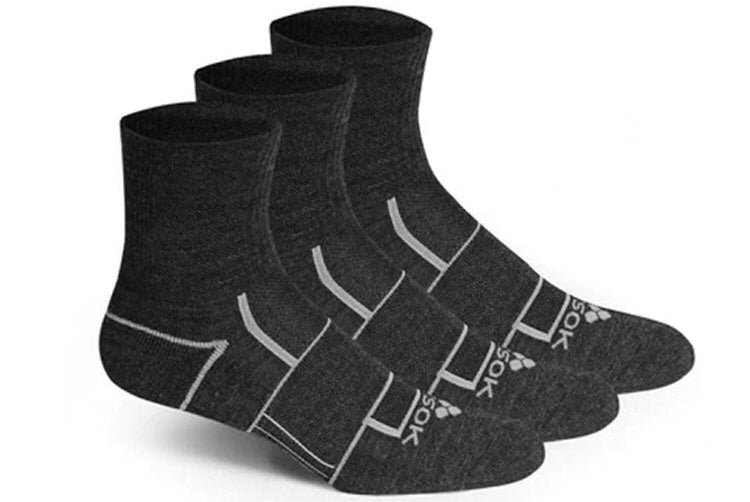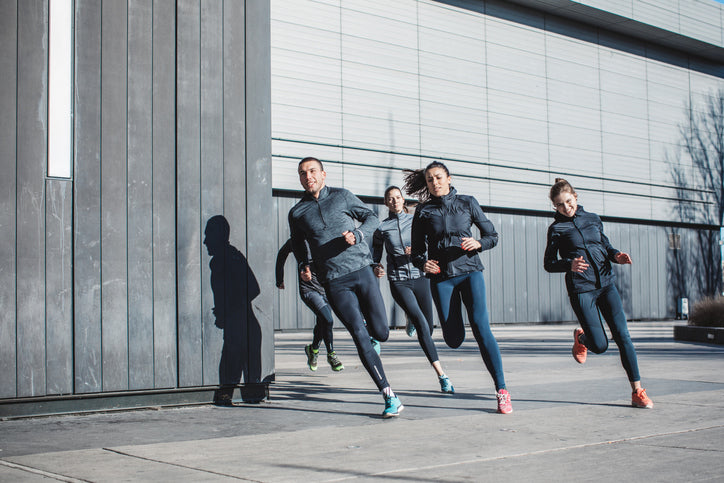We should all know that warming up is a vital part of getting ready to go for a run, but did you know there's a proper way to do it? Running can be hard on our muscles and joints; with a proper warm-up, we can better protect them. Running is considered high-impact, so we put together a few ways to warm up before a run to ensure you're ready.
Warming up can look different for everyone, we all have different ways we like to prepare for a run. But are you getting a good, proper warm-up before beginning your run? Stretching before your pre-run or workout process is a great way to begin your warming up. Stretching before you work out is good for your muscles, joints, and ligaments and reduces your risk of injury as you loosen your muscles. It also can increase your range of motion in your knees, hips, quads, and hamstrings.
You want to steer clear of explosive and static stretching. Static stretching is stretching your limbs to their furthest point and holding them for around 45 seconds or so. Aside from the danger of hyperextension, it also isn't doing anything to warm you up. Instead, practice dynamic stretches. Dynamic stretches are specific movements that prepare your joints, muscles, and connective tissue for exertion and use.
When starting your warm-up, start slowly and wake your muscles up gently. You want to get your blood flowing and your heart to start pumping before you take off for a run. The goal is to stimulate our muscles and lower their resistance, so they're ready for the impact that running brings on them. There are many forms of warm-ups, so we want to make sure we are thoroughly warmed up before beginning our more intense portion of the workout. When doing these warm-ups, a good rule of thumb is to do everything in groups of 10 on each side for each direction.
Here's a great way to start your warm-up:
• First, start by standing straight and bringing your knees to your chest for 10 seconds each a couple of times. Try bringing them as close to your chest as you can without straining.
• Next we will want to do some leg swings. You'll want to swing both legs front and back about 10 times each. By doing this, we're getting the blood flowing and getting some range of motion in our legs. You don't have to swing high, just high enough to where you are comfortable.
• Follow with swinging your legs in a circular motion 10 times each to loosen up the hip joints.
• Knees! We don't want to forget knee circles. Running can very easily cause knee injuries, so to prevent that, we should start with light movement by circling them gently about 10 times each way.
• Next, up, focus on the neck and shoulder. Start with some simple neck rolls, and don't forget to roll both ways! Shoulder rolls, both forward and backward, will help loosen your arms up. When we run, we use our arms, so it's just as important to loosen them up as it is your legs.
• Finally, include some arm circles by sticking them out to the side and rotating them forward and backward ten times in each direction. For extra measure, add in some wrist rotations; it feels good to get the whole arm moving, so add in 10 wrist circles in each direction.
Now it's time to kick things up a bit… literally. You will want to do some heel-to-butt kicks in place to move the legs a bit more intensely. This is a good way to gradually pick up your warm-up pace. Another benefit to this is that it starts to pick up your heart rate and get your quads loosened up. Then we will want to do forward skips to get some motion going. Next, we will do some mountain climbers. This warm-up is good for multiple reasons, you might even break into a small sweat which is good, and we're getting the body temperature slightly up and prepared for the run.
Jogging in place slowly, marching, and some jumping jacks are all good forms of warming up before your run. These light exercises are great for stepping up toward the end of your warm-up and ensuring you are ready to go. Side squats and lunges are great to add to your warm-up regimen. When it comes to warming up, your goal is to hit all the major muscle groups and joints, preparing them for motion and exertion.
Now that we know how to do a good and thorough warm-up, you will notice a difference not only during your run but also after. Adding a thorough and thoughtful warm routine before every run will bring you many benefits, reduce pain, increase the amount of enjoyment you get from your runs, and help protect you from strains, sprains, and injuries. Couple them with a purposeful cool-down every run, and you'll be making the most of every run
We should all know that warming up is a vital part of getting ready to go for a run, but did you know there's a proper way to do it? Running can be hard on our muscles and joints; with a proper warm-up, we can better protect them. Running is considered high-impact, so we put together a few ways to warm up before a run to ensure you're ready.
Warming up can look different for everyone, we all have different ways we like to prepare for a run. But are you getting a good, proper warm-up before beginning your run? Stretching before your pre-run or workout process is a great way to begin your warmng up. Stretching before you work out is good for your muscles, joints, and ligaments and reduces your risk of injury as you loosen your muscles. It also can increase your range of motion in your knees, hips, quads, and hamstrings.
You want to steer clear of explosive and static stretching. Static stretching is stretching your limbs to their furthest point and holding them for around 45 seconds or so. Aside from the danger of hyperextension, it also isn't doing anything to warm you up. Instead, practice dynamic stretches. Dynamic stretches are specific movements that prepare your joints, muscles, and connective tissue for exertion and use.
When starting your warm-up, start slowly and wake your muscles up gently. You want to get your blood flowing and your heart to start pumping before you take off for a run. The goal is to stimulate our muscles and lower their resistance, so they're ready for the impact that running brings on them. There are many forms of warm-ups, so we want to make sure we are thoroughly warmed up before beginning our more intense portion of the workout. When doing these warm-ups, a good rule of thumb is to do everything in groups of 10 on each side for each direction.
Here's a great way to start your warm-up:
• First, start by standing straight and bringing your knees to your chest for 10 seconds each a couple of times. Try bringing them as close to your chest as you can without straining.
• Next we will want to do some leg swings. You'll want to swing both legs front and back about 10 times each. By doing this, we're getting the blood flowing and getting some range of motion in our legs. You don't have to swing high, just high enough to where you are comfortable.
• Follow with swinging your legs in a circular motion 10 times each to loosen up the hip joints.
• Knees! We don't want to forget knee circles. Running can very easily cause knee injuries, so to prevent that, we should start with light movement by circling them gently about 10 times each way.
• Next, up, focus on the neck and shoulder. Start with some simple neck rolls, and don't forget to roll both ways! Shoulder rolls, both forward and backward, will help loosen your arms up. When we run, we use our arms, so it's just as important to loosen them up as it is your legs.
• Finally, include some arm circles by sticking them out to the side and rotating them forward and backward ten times in each direction. For extra measure, add in some wrist rotations; it feels good to get the whole arm moving, so add in 10 wrist circles in each direction.
Now it's time to kick things up a bit… literally. You will want to do some heel-to-butt kicks in place to move the legs a bit more intensely. This is a good way to gradually pick up your warm-up pace. Another benefit to this is that it starts to pick up your heart rate and get your quads loosened up. Then we will want to do forward skips to get some motion going. Next, we will do some mountain climbers. This warm-up is good for multiple reasons, you might even break into a small sweat which is good, and we're getting the body temperature slightly up and prepared for the run.
Jogging in place slowly, marching, and some jumping jacks are all good forms of warming up before your run. These light exercises are great for stepping up toward the end of your warm-up and ensuring you are ready to go. Side squats and lunges are great to add to your warm-up regimen. When it comes to warming up, your goal is to hit all the major muscle groups and joints, preparing them for motion and exertion.
Now that we know how to do a good and thorough warm-up, you will notice a difference not only during your run but also after. Adding a thorough and thoughtful warm routine before every run will bring you many benefits, reduce pain, increase the amount of enjoyment you get from your runs, and help protect you from strains, sprains, and injuries. Couple them with a purposeful cool-down every run, and you'll be making the most of every run.







Leave a comment
This site is protected by hCaptcha and the hCaptcha Privacy Policy and Terms of Service apply.